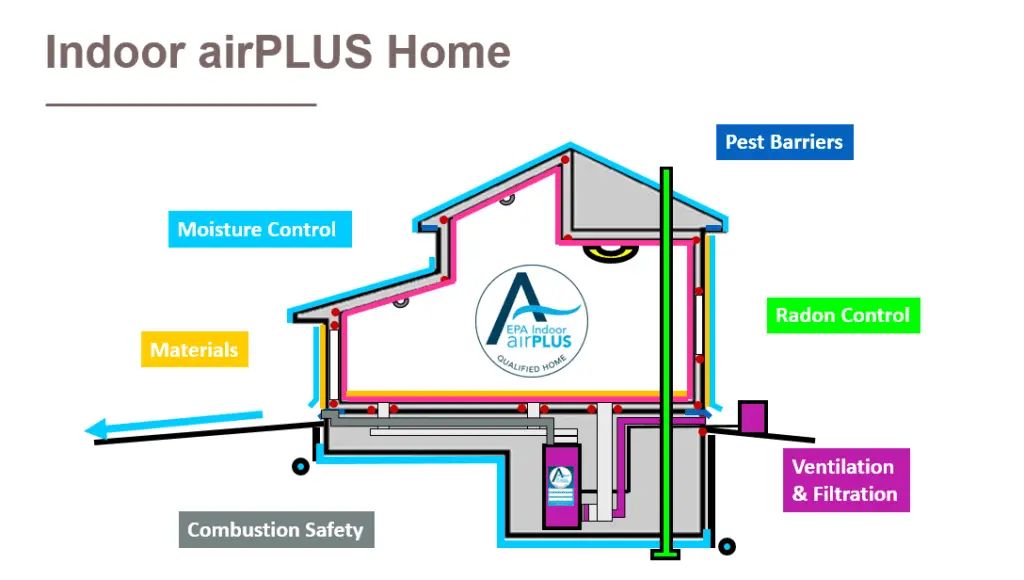
When Sara Willoughby was 14 years old, she became bedridden with debilitating health problems. “I wasn’t able to do much more than roll over,” she recalls. “I needed help with basic activities like bathing and eating.” After being diagnosed with sensitivity to mold and other chemicals in their Washington-state home, the family decided to move to Arizona and look for a new, healthier home.
They ended up buying from C&B Custom Homes in Cottonwood, a company they were drawn to because of its affiliation with Indoor Air Plus (IAP), a voluntary EPA program that certifies builders who follow a rigorous set of best practices to ensure good indoor air quality.
Four years later, Sara says her health is much better, thanks in large part to that new home. “It has given me a place where I can heal, she says.” “I’m about 75 percent better now. I’m able to ride horses and can even go for hikes.”
While Sara Willoughby’s case is an extreme one, it illustrates the potential problems with our indoor environments. Health concerns have risen to the top of many consumers’ priority list, which made affiliating with IAP one of C&B’s best-ever business decisions, according to company spokesperson Lori Bullock. “Not long after signing on to the program, people with chemical sensitivities and other health problems were seeking us out,” she says.
Certifying Air Quality
If you haven’t heard of Indoor Air Plus, that’s no surprise. It has been around since 2008, but lacks the name recognition of Energy Star. “We formed just before the last housing recession, so it didn’t start catching on until about 2015 when construction picked up again,” according to program manager Nick Hurst. It now has 430 active builder partners in all parts of the country and has certified around 19,000 homes.
Certification is only available to builders already meeting Energy Star standards. Those standards include air sealing and mechanical ventilation.
The additional requirements imposed by IAP include enhanced air filtration, better moisture control in high-humidity areas such as the Southeast, and radon protection (where that’s an issue). The program also limits Volatile Organic Compounds (VOCs) – chemicals that break down over time and off-gas toxic vapors; they are used in many paints, adhesives, and carpets. To earn IAP certification, the home must use materials that emit little or no VOCs.
These additional requirements shouldn’t be difficult for an Energy Star builder. Since signing on with IAP five years ago, Phoenix-area Fulton Homes switched to low-VOC materials and started installing electronic air cleaners and radon detectors in its homes. They also seal ducts during construction to keep them from getting filled with drywall dust and other contaminants that could blow into the house later. Dennis Webb, Fulton’s VP of operations, says the extra cost per home over Energy Star is just a few hundred dollars, which the company has decided to absorb.
Addressing Consumer Worries
Builders who sign on to IAP understand that concern over how a home will affect the family’s well-being is a greater motivator than ever. One of builders these is Denver-area Thrive, which has spent years building a brand around offering Zero Energy homes, which are so energy-efficient that a modest solar array generates as much annual power as the home uses.
Despite that established brand, Thrive recently pivoted its marketing message from energy to clean air because their buyers find it more compelling. “A lot of our clients care more about health,” says Susan Elovitz, the company’s director of marketing. “We see it as the next frontier.” For instance, one of Thrive’s ads shows a mother feeding her baby. The tagline: “What she’s breathing is as important as what you’re feeding her.”
While Thrive focuses on health in general, Fulton’s message aims squarely at concerns about asthma, which, according to the Centers for Disease Control, affects nearly 8 percent of all U.S. residents, and more than 11 percent of teenagers.[i] Webb says it’s worse in his market. “About 12 percent of kids in Arizona have asthma, and if your kid is one of them, health becomes way more important than granite countertops,” he says. “We simply ask people if they would rather live in a home with healthy air or stale air.”
The fact that everyone answers in the affirmative makes the small extra cost of IAP a cheap marketing investment. “It’s an awesome tool that gives us a decisive advantage,” says Webb. Fulton puts the Indoor Air Plus label on brochures, floor plans, price sheets, and the front door of the design center. Its salespeople are also trained to talk with customers about the program.
The growing asthma problem has also led big production builders to sign on with IAP, including KB Home and Meritage, who operate across the U.S. “We design our homes to help improve the air quality for somebody who has allergies or children with asthma,” says CR Herro, the company’s VP of Innovation. “Our standard approach follows the best homebuilding practices established by the U.S. EPA.”
Ensuring Compliance
Of course, many great builders specialize in healthy homes, and even those who don’t subscribe to Indoor Air Plus may meet or exceed the program’s standards. So why care about certification?
One reason is IAP’s systematic approach. “We provide builders with a checklist they can follow,” says Hurst. This helps ensure the job is done well.
Another is that it keeps builders up-to-date. Hurst says the next program revision, which should be completed in 2020, will include stricter requirements for air filtration and carbon monoxide detection, as well as clarification for builders and designers on how to control humidity. “We’re revising things based on the past 10 years of industry experience,” he says.
But the biggest differentiator is the program’s accountability. Builders can’t just say they’re following that checklist; every single home has to be inspected and certified by an independent, IAP-trained evaluator. “We offer homeowners the certainty that comes from a non-biased third party putting a stamp of approval on their home,” says Hurst.
Homeowners Still Responsible
While homeowners looking for a healthy home would be well-advised to talk with an Indoor Air Plus builder, they need to remember that construction details aren’t enough and that the builder won’t make any health guarantees. “We make it clear that we’re certified by EPA because we follow the steps required by the program and our work is verified by third-party inspection company,” say Webb.
In other words, homeowners still are still accountable for their choices. If you smoke or engage in hobbies that involve toxic chemicals, your family will suffer the consequences if you do those activities inside the house. For instance, Heather Willoughby, Sara’s mother, says while the new home C&B built for them has been a boon to her daughter’s health, the family is very careful with the items they purchase. Nothing is allowed in the house, including furniture, unless it’s old enough to have off-gassed all chemical vapors or has no off-gassing potential to begin with. Even things like laundry detergents are kept in the garage. However, the certification that their home isn’t contributing to the problem makes those choices a lot more effective, and has a drastic positive impact on their lives.

Charlie Wardell is a licensed builder and a writer and editor with more than 20 years of experience covering home building and construction.
A Massachusetts resident, his work has appeared in some of the nation’s leading media brands in print and online.
In addition to his exclusive articles for NewHomeSource, Charlie has written or edited for publications that include Architectural Record, Custom Builder, Fine Homebuilding, Green Builder, Harvard Management Update, Popular Science and This Old House.
 Tiny Houses: Are they Legal?
Tiny Houses: Are they Legal?